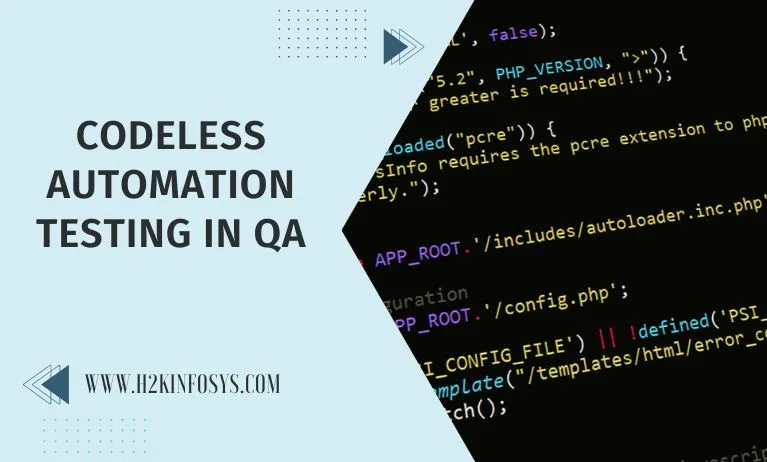Code-based automation and efficient but time-consuming manual testing in QA has always produced the greatest possible product quality. However, such a strategy doesn’t work in the IT industry, which is always evolving. Combining manual and codeless automation technologies to transform QA testing appears to be a promising solution. Let’s determine the cause. To learn more about Codeless Automation testing, check out the QA course.
How does codeless testing work?
It takes time, perseverance, and work to master learning programming languages. Because automation testers are a hybrid of a programmer and a QA engineer, they would feel like they were in a dangerous area. Even though modern testers gain a thorough understanding of many technologies, coding frequently diverts QA experts from their core duties. As a result, the “codeless future” has been used as a backdrop to reconsider the previous role of QA engineers.

To be clear, the idea of “codeless testing” shouldn’t be taken too literally. The phrase itself describes a test case automation strategy that uses little to no coding. On top of the test code, an abstraction layer is created by scriptless testing tools. This means that in order to test a scenario, the test scripts still rely on specific software components. But creating or modifying these test scripts doesn’t require hard coding.
For web-based product testing, the “record-and-play” method has been the most widely used. An engineer for quality assurance runs a test by hand and utilises the tool to meticulously record it. After that, the program automates the test and generates the scripts. In this method, QA engineers make the process time-consuming by doing the same tests on various goods. The recorded scripts can also be edited by testers, who can also modify their QA procedures to fit the needs of the product. Most automation programs come with comprehensive end-user manuals, so using them usually doesn’t require substantial training. And that is what transforms the code-based testing world into codeless.
Benefits of Codeless Test Automation
There are some apparent and less obvious reasons why you should think about including codeless testing in QA process, even though the approach is not totally code-free.
- It is simple.
Automation requires less work from the team. Tools for codeless testing boost test coverage, which raises the bar for software QA. These technologies make it simple for QA engineers to build, control, and maintain even complicated test scripts.
- It does not take a lot of time.
Since no coding experience is necessary, the testers can quickly automate a test scenario. It makes it possible to concentrate on software testing and bug fixing rather than initially managing the complex code.
- It is cost-effective.
With codeless automation technologies, you may contribute to the process without having to recruit more expertise. However, keep in mind that despite being available for free, open-source tools still demand significant expenditures for testing, maintenance, and technical expert support.
- Its user interface is friendly.
The entire testing procedure is made easier and more convenient by a simple GUI. Because of this, working with codeless automation solutions is a skill that QA specialists may easily learn.
Codeless UI Testing
Running GUI tests using codeless testing has proven to be particularly successful. Here, QA engineers automate and record user-like behavior. As soon as UI development is complete, test cases can be automated. The code is buried and testers don’t have to navigate difficult frameworks if automation is created for visual workflow.

Furthermore, if GUI testing is carried out using codeless testing tools, there is no need for developers to create UI tests. Multiple desktop and web applications are available on flexible modern automation platforms. It means that the product is tested automatically to see how it functions on various devices.
Codeless Automation Testing Tools & Platforms
- CloudQA.
It is a simple test management application with a useful visual editor. The tool records the tests and logs every action taken while the QA engineer navigates the website while clicking and interacting with the software. Additionally, it makes it simple to switch between environments and browsers.
- TestingWhiz.
This tool is appropriate for API, cloud, online, and mobile testing. Additionally, it adheres to the “record-and-play” principle and integrates quickly with other bug-tracking software.
- Katalon Studio.
This one is effective at automatically creating tests. It produces the necessary scripts by recording the tester’s online or app interactions. Web, Android, and iOS are supported by Katalon Studio, which also interacts with JIRA, Git, and Jenkins.
- Ranorex.
This toolkit is for end-to-end testing of desktop, mobile, or web applications. QA engineers can quickly run automated tests created using Ranorex on Android or iOS mobile devices after automating them on Windows. Additionally, the tool supports the execution of cross-browser tests for Firefox, Safari, Microsoft Edge, Chrome, etc.
- Selenium IDE.
It is one of the easiest tools for recording and playback automation. Testers can reuse a test case inside of another by using the run command. Plugins allow the tool to be expanded. They either interact with other services or add new commands to the IDE.
- Sahi Pro.
This tool for record-playback without code creates tests based on keywords and data. It does not require complex code authoring and is easy to use across several browsers (Opera, Firefox, Explorer, and Chrome). Java, Win 32, and WPF Windows desktop applications as well as iOS, Android, Native, and Hybrid mobile apps are all supported by Sahi Pro for test automation.
Conclusion
Software development businesses are under pressure from fierce competition and quickly advancing creative solutions. Competitors reduce release cycles, add new features fast, and take advantage of market trends to quickly upgrade the product in an effort to win users’ attention and loyalty. It may be possible to speed up the entire development process by adhering to the conventional route of manual testing in QA expertise and the addition of codeless technologies to automate repetitive work. A good QA training course will explain Codeless Automation Testing in detail.































One Response